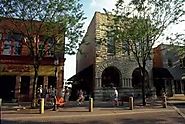-
About
- About Listly
- Community & Support
- Howto
- Chrome Extension
- Bookmarklet
- WordPress Plugin
- Listly Premium
- Privacy
- Terms
- DMCA Copyright
- © 2010-2025 Boomy Labs


 Gail Zahtz
Gail Zahtz
Listly by Gail Zahtz
Organizations, resources and support as well as individual examples for new urbanism, walkable communities and other pro-community movements and examples, especially those conducive to Baby Boomers living with their families and support nearby. Most of these emphasize sustainability and/or open, shared green spaces. Steps involved in creating and maintaining home communities.

Manifesto:

The Center for Applied Transect Studies (CATS) promotes understanding of the built environment as part of the natural environment, through the planning methodology of the rural-to-urban transect. CATS supports interdisciplinary research, publication, tools, and training for the design, coding, building and documentation of resilient transect-based communities. They support:
Walkable, transit-connected communities
Comprehensive zoning reform
Context-based thoroughfare design and engineering
Affordable housing and income diversity
Regional, local, and individual food production
Passive climatic response in building and urban design
Reduction of environmental impacts and costs of infrastructure
Development and use of renewable energy technologies
Repair of unsustainable sprawl patterns

The movement has a number of definitions and tools that are integral to the understanding, a few of which are explained below: *More tools coming soon. The Charrette A charrette is an intensive planning session where citizens, designers and others collaborate on a vision for development. It provides a forum for ideas and offers the unique advantage of giving immediate feedback to the designers. More importantly, it allows everyone who participates to be a mutual author of the plan.

Dorset is first new urban community in the U.K. It is supported by the Prince of Whales.

The Form-Based Codes Institute (FBCI) is a non-profit professional organization dedicated to advancing the understanding and use of form-based codes http://formbasedcodes.org/ Symposium on urban form for as framework for healthy communities.

While Kentlands may not seem all that large, the distance from the Clubhouse complex with its many facilities to our community’s most distant locations is almost a mile. Well, it turns out that almost all our community activities – and activities are a significant chunk of our budget -take place at the Clubhouse complex. That’s very convenient for those of us who live in the 400 block of Tschiffely Square Road, but less so for others. […]

In every organization and in every endeavor, creating innovative solutions to complex problems requires collaboration – and necessarily involves conflicting positions. How can you avoid endless meetings and participant burnout while channeling divergent viewpoints into co-action?The National Charrette Institute (NCI) is a nonprofit educational institution. We help people build community capacity for collaboration to create healthy community plans. We teach professionals and community leaders the art and science of the NCI Charrette System™, a holistic, collaborative planning process that harnesses the talents and energies of all interested parties to create and support a feasible plan. And we advance the fields of community planning and public involvement through research and publications.

The National Town Builders’ Association is organized to serve builders and developers throughout the nation in an effort to build the very best traditional neighborhoods and town centers.

Here’s our Mission. Want to know more About Us, including our history? Here’s our list of Members... you’ll likely find some familiar names here, and you really should get acquainted with the rest of the Guild, too... it’s a remarkable group of architects and designers. Our Affiliates program will soon be online... it will include other architects, designers, planners, developers, or builders, who support Guild principles. Here’s our News Archive of current and previous stories, and here’s how to Contact Us.
The New Urban Guild is dedicated to promoting the creation of better places through traditional patterns and languages of architecture and urbanism. We view the pervasiveness of disposable buildings, placeless buildings, forgettable buildings and unlovable buildings as the natural end-product of any theory of architecture that is not based primarily on human beings.
Human-based architecture has always evolved with time. It embraces technological advances not for their own sake, but for what they can do for human beings. Because it engages the public at large, human-based architecture has the power to make technological advances ubiquitous, mass-produced and therefore affordable. Human-based architecture is, therefore, the only sustainably modern architecture.

New urbanism is the revival of our lost art of place-making, and promotes the creation and restoration of compact, walkable, mixed-use cities, towns, and neighborhoods, while providing solutions to global warming and peak oil. See the principles and benefits at http://www.newurbanism.org/newurbanism/principles.html

The Source for Urban Planning, Walkable Communities & Smart Growth

The architecture of Seaside extends beyond its roof lines and materials. Beyond its styles. Beyond Charleston, Victorian, Antebellum, or various Revivals. Yes. All of these details and influences comprise the architecture of Seaside.

We help people create great communities. They focus on:
Documenting the founding and development of the community of Seaside, which is widely considered the birthplace of land use planning philosophy known as the New Urbanism,
Educating public officials, students, professionals and the general public about the benefits and techniques of New Urbanism, including the study of historical precedents, and
Fostering education, cultural activities and the arts within Seaside and the surrounding area.

